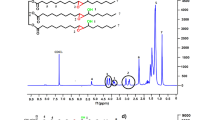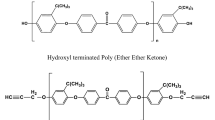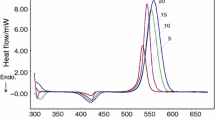Abstract
The curing kinetics of self-healing epoxy compositions was investigated by non-isothermal differential scanning calorimetric (DSC) studies. Cycloaliphatic epoxy resin was encapsulated in urea–formaldehyde (UF) using emulsion polymerisation technique to prepare epoxy-loaded UF microcapsules. Triethylene tetramine (TETA) hardener was immobilised on a mesoporous siliceous substrate (SBA 15) and both these additives were dispersed into an epoxy resin, which was subsequently cured using TETA. DSC studies revealed the autocatalytic nature of epoxy curing, which remained unaltered due to addition of the above-mentioned fillers, responsible for introducing self-healing functionality. The kinetic parameters of the curing process were determined using both Friedman and Kissinger–Akahira–Sunose (KAS) method. The activation energy at different degrees of conversion (E α ) was found to decrease with increasing degree of cure (α). Although UF resins possess secondary amine functionalities, which have the potential to react with the epoxy groups, no significant differences in the curing kinetics of the base resin were observed. Kinetic parameters were used to predict the curing behaviour of compositions at higher heating rates using KAS method. As expected, the onset curing temperature (T onset) and peak exotherm temperature (T p) of epoxy shifted towards higher temperatures with increased heating rate; however, introduction of fillers does not affect these characteristic temperatures significantly. Also, the overall order of reaction does not vary significantly which supports the autocatalytic nature of curing reaction. The results suggests that although 2° amino groups are available with the UF resin, these do not directly participate in the curing reaction, as the primary amino groups in TETA are more easily accessible.









Similar content being viewed by others
References
Yang Y, Urban MW. Self-healing polymeric materials. Chem Soc Rev. 2013;42(17):7446–67.
Scheltjens G, Brancart J, Graeve I, Mele B, Terryn H, Assche G. Self-healing property characterization of reversible thermoset coatings. J Therm Anal Calorim. 2011;105(3):805–9.
Sharma P, Shukla S, Lochab B, Kumar D, Roy PK. Microencapsulated cardanol derived benzoxazines for self-healing applications. Mater Lett. 2014;. doi:10.1016/j.matlet.2014.07.048.
White SR, Sottos NR, Geubelle PH, Moore JS, Kessler MR, Sriram SR, et al. Autonomic healing of polymer composites. Nature. 2001;409(6822):794–7.
Kessler MR, Sottos NR, White SR. Self-healing structural composite materials. Compos A. 2003;34(8):743–53.
Brown EN, White SR, Sottos NR. Microcapsule induced toughening in a self-healing polymer composite. J Mater Sci. 2004;39(5):1703–10.
Yuan L. Preparation and characterization of poly(urea-formaldehyde) microcapsules filled with epoxy resins. Polym Degrad Stab. 2006;47:5338–49.
Bleay SM, Loader CB, Hawyes VJ, Humberstone L, Curtis PT. A smart repair system for polymer matrix composites. Compos A Appl Sci Manuf. 2001;32(12):1767–76.
Pang JWC, Bond IP. A hollow fibre reinforced polymer composite encompassing self-healing and enhanced damage visibility. Compos Sci Technol. 2005;65(11–12):1791–9.
Jin H, Mangun CL, Stradley DS, Moore JS, Sottos NR, White SR. Self-healing thermoset using encapsulated epoxy-amine healing chemistry. Polymer. 2012;53(2):581–7.
Yin T, Rong M, Zhang LM. Self-healing epoxy composites—part I: curing kinetics and heat-resistant performance. Adv Mater Res. 2013;716:383–6.
Hudson S, Magner E, Cooney J, Hodnett BK. Methodology for the immobilization of enzymes onto mesoporous materials. J Phys Chem B. 2005;109(41):19496–506.
Karimi B, Emadi S, Safari AA, Kermanian M. Immobilization, stability and enzymatic activity of albumin and trypsin adsorbed onto nanostructured mesoporous SBA-15 with compatible pore sizes. RSC Adv. 2014;4:4387–4394.
Yiu HHP, Wright PA, Botting NP. Enzyme immobilisation using SBA-15 mesoporous molecular sieves with functionalised surfaces. J Mol Catal B Enzym. 2001;15(1–3):81–92.
Chaudhary S, Parthasarathy S, Kumar D, Rajagopal C, Roy PK. Graft-interpenetrating polymer networks of epoxy with polyurethanes derived from poly(ethyleneterephthalate) waste. J Appl Polym Sci. 2014;131:40490.
Chaudhary S, Parthasarathy S, Kumar D, Rajagopal C, Roy PK. Poly(ethyleneterephthalate) glycolysates as effective toughening agents for epoxy resin. J Appl Polym Sci. 2014;131:39941.
Ramírez C, Abad MJ, Barral L, Cano J, Díez FJ, López J, et al. Thermal behaviour of a polyhedral oligomeric silsesquioxane with epoxy resin cured by diamines. J Therm Anal Calorim. 2003;72(2):421–9.
Tong XM, Zhang M, Yang MZ. Study on the curing kinetics of epoxy resin in self-healing microcapsules with different shell material. Adv Mater Res. 2011;306–307:658–62.
Ghaemy M, Yaghoob S, Karimi M. Curing kinetics of DGEBA/UF resin system used as laminates in impregnated decorative paper. Iran Polym J. 2010;19(9):661–8.
Rosso P, Ye L. Epoxy/Silica nanocomposites: nanoparticle-induced cure kinetics and microstructure. Macromol Rapid Commun. 2007;28(1):121–6.
Tripathi M, Rahamtullah, Kumar D, Rajagopal C, Roy PK. Influence of microcapsule shell material on the mechanical behavior of epoxy composites for self-healing applications. J Appl Polym Sci. 2014;131:40572.
Yuan YC, Rong MZ, Zhang MQ, Chen J, Yang GC, Li XM. Self-healing polymeric materials using epoxy/mercaptan as the healant. Macromolecules. 2008;41(14):5197–202.
Meynen V, Cool P, Vansant EF. Verified syntheses of mesoporous materials. Microporous Mesoporous Mater. 2009;125(3):170–223.
Naskar MK, Eswaramoorthy M. Significant improvement in the pore properties of SBA-15 brought about by carboxylic acids and hydrothermal treatment. J Chem Sci. 2008;120(1):181–6.
Brown EN. In situ poly(urea-formaldehyde) microencapsulation of dicyclopentadiene. J Microencapsul. 2003;20(6):719–30.
Salaün F, Vroman I. Influence of core materials on thermal properties of melamine–formaldehyde microcapsules. Eur Polym J. 2008;44(3):849–60.
Roy PK, Ullas AV, Chaudhary S, Mangla V, Sharma P, Kumar D, et al. Effect of SBA-15 on the energy absorption characteristics of epoxy resin for blast mitigation applications. Iran Polym J. 2013;22(9):709–19.
Wang J, Laborie M-PG, Wolcott MP. Comparison of model-free kinetic methods for modeling the cure kinetics of commercial phenol–formaldehyde resins. Thermochim Acta. 2005;439(1–2):68–73.
Budrugeac P, Segal E. Applicability of the Kissinger equation in thermal analysis. J Therm Anal Calorim. 2007;88(3):703–7.
Doyle CD. Kinetic analysis of thermogravimetric data. J Appl Polym Sci. 1961;5(15):285–92.
Ghumara R, Adroja P, Parsania PH. Synthesis, characterization, and dynamic DSC curing kinetics of novel epoxy resin of 2,4,6-tris(4-hydroxyphenyl)-1-3-5-triazine. J Therm Anal Calorim. 2013;114(2):873–81.
Prime RB. Thermal characterization of polymeric materials. New York: Academic; 1997.
Author information
Authors and Affiliations
Corresponding author
Electronic supplementary material
Below is the link to the electronic supplementary material.
Rights and permissions
About this article
Cite this article
Tripathi, M., Kumar, D., Rajagopal, C. et al. Curing kinetics of self-healing epoxy thermosets. J Therm Anal Calorim 119, 547–555 (2015). https://doi.org/10.1007/s10973-014-4128-1
Received:
Accepted:
Published:
Issue Date:
DOI: https://doi.org/10.1007/s10973-014-4128-1




